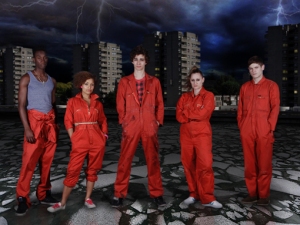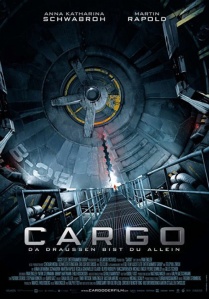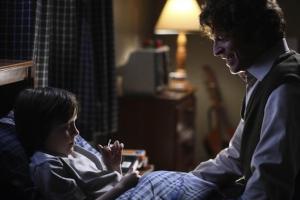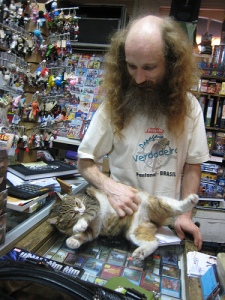Fan Expo Canada, a three-day convention in Toronto for all things nerdy, is always a hectic weekend. Despite its increase in popularity over the years, the frustration (and resulting pen stabbings) caused by crowds and line-ups have never reached San Diego Comic-Con heights. This year however, Fan Expo had some new obstacles, so I wanted to share my thoughts on the event (including the highlights, the loot and the hassles).
 On Friday night, I attended a screening of the 1966 film, “Batman” (starring Adam West and Burt Ward) at the Toronto Underground Cinema. Although several of the film’s hilariously campy scenes have appeared online (including the infamous exploding shark), I had never seen the movie in full. I’m not sure what I was expecting, but “Batman” was the most hilarious movie I’ve seen all year. Besides Robin’s usual one-liners (“Holy bikini, Batman!”), I was amused the most by the obsessive-compulsive way every important button, switch or lever was labeled with its name and/or function. Most notably, midway down the Batpole, Bruce Wayne hits the “Instant Costume-Change Lever,” allowing the dynamic duo to seamlessly and instantly change into their superhero apparel.
On Friday night, I attended a screening of the 1966 film, “Batman” (starring Adam West and Burt Ward) at the Toronto Underground Cinema. Although several of the film’s hilariously campy scenes have appeared online (including the infamous exploding shark), I had never seen the movie in full. I’m not sure what I was expecting, but “Batman” was the most hilarious movie I’ve seen all year. Besides Robin’s usual one-liners (“Holy bikini, Batman!”), I was amused the most by the obsessive-compulsive way every important button, switch or lever was labeled with its name and/or function. Most notably, midway down the Batpole, Bruce Wayne hits the “Instant Costume-Change Lever,” allowing the dynamic duo to seamlessly and instantly change into their superhero apparel.
Following the screening, the caped crusader himself, Mr. Adam West, appeared on stage to answer fan questions and indulge our requests. West’s ability to self-ridicule was reminiscent of William Shatner (West even noted that there were only a few people in Hollywood like himself who were able to poke fun at themselves), as he performed the “Batusi” and lines from Family Guy’s Mayor West (including, “Someone’s stealing my water”).
 The next day at Fan Expo, fans were treated to a disorganized mess of cosplay and line-ups that spanned city blocks. Inside, the crowds were nearly impossible to navigate, and if you were lucky enough to actually make it into a room for a panel with one of your favourite celebrities, you had the privilege of almost being crushed to death while trying to exit through the narrow hallways. And unlike the hordes of people you might encounter at a sports game or a concert, the over-sized nature of cosplayers’ weapons and costumes definitely make large crowds a little more… difficult. (Trust me, getting smushed between Iron Man and a stormtropper isn’t as awesome as it sounds.)
The next day at Fan Expo, fans were treated to a disorganized mess of cosplay and line-ups that spanned city blocks. Inside, the crowds were nearly impossible to navigate, and if you were lucky enough to actually make it into a room for a panel with one of your favourite celebrities, you had the privilege of almost being crushed to death while trying to exit through the narrow hallways. And unlike the hordes of people you might encounter at a sports game or a concert, the over-sized nature of cosplayers’ weapons and costumes definitely make large crowds a little more… difficult. (Trust me, getting smushed between Iron Man and a stormtropper isn’t as awesome as it sounds.)
Hobby Star Marketing President and CEO, Aman Gupta, apologized for the inadequate planning at Fan Expo and addressed the concerns of fans in a recent letter, stating that the company was unprepared for such an outpour of fans. Gupta also promised that Fan Expo 2011 would be held in a larger space — the entire South Metro Toronto Convention Centre.
However, despite the crowds and the lines, I must say that I thoroughly enjoyed this year’s Fan Expo.
Some of my highlights included:
- Felicia Day. The Q&A with Felicia Day (writer, creator, and star of the “The Guild” webseries) was a lot of fun and let me bask in the awesomeness of my fantasy BFF. The one hour Q&A allowed fans to ask questions like “What’s your favourite video game of all time?” And, ” How does it feel to make girl gaming more mainstream?” Felicia’s passion for gaming, social media and writing came through loud and clear, as well as her knowledge of obscure video games. Afterwards, she signed my copy of issue #1 of The Guild comic, which I also got signed by artist Jim Rugg at the Toronto Comic Arts Festival in May. Unfortunately, I was so starstruck and engulfed in our conversation that I forgot to ask Felicia for a photo together.
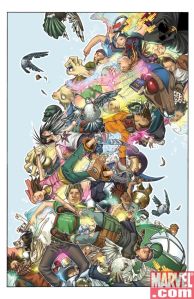 Artist Alley. The area for artists was much larger this year, allowing for more crafts, art and interesting conversations. I always try to spend most of my time in Artist Alley, as the rest of the exhibitors typically sell posters, comics and merch that I can pick-up at any of my local comic-book stores. Artist Alley, on the other hand, features original and hard-to-find pieces that the creators are more than happy to talk about (and sign for you). This year I picked-up some great new posters and got to chat with quite a few artists, including Runaways artist Adrian Alphona.
Artist Alley. The area for artists was much larger this year, allowing for more crafts, art and interesting conversations. I always try to spend most of my time in Artist Alley, as the rest of the exhibitors typically sell posters, comics and merch that I can pick-up at any of my local comic-book stores. Artist Alley, on the other hand, features original and hard-to-find pieces that the creators are more than happy to talk about (and sign for you). This year I picked-up some great new posters and got to chat with quite a few artists, including Runaways artist Adrian Alphona.- The costumes. Cosplayers are always out in force at Fan Expo, and this year was no different. I’m always amazed at the detail that goes into every costume — envious of the time, effort and talent that goes into each piece. Next year, I think I’ll join in the fun and cosplay as Atom Eve, a superhero and love interest in Robert Kirkman’s Invincible comic-book series.














